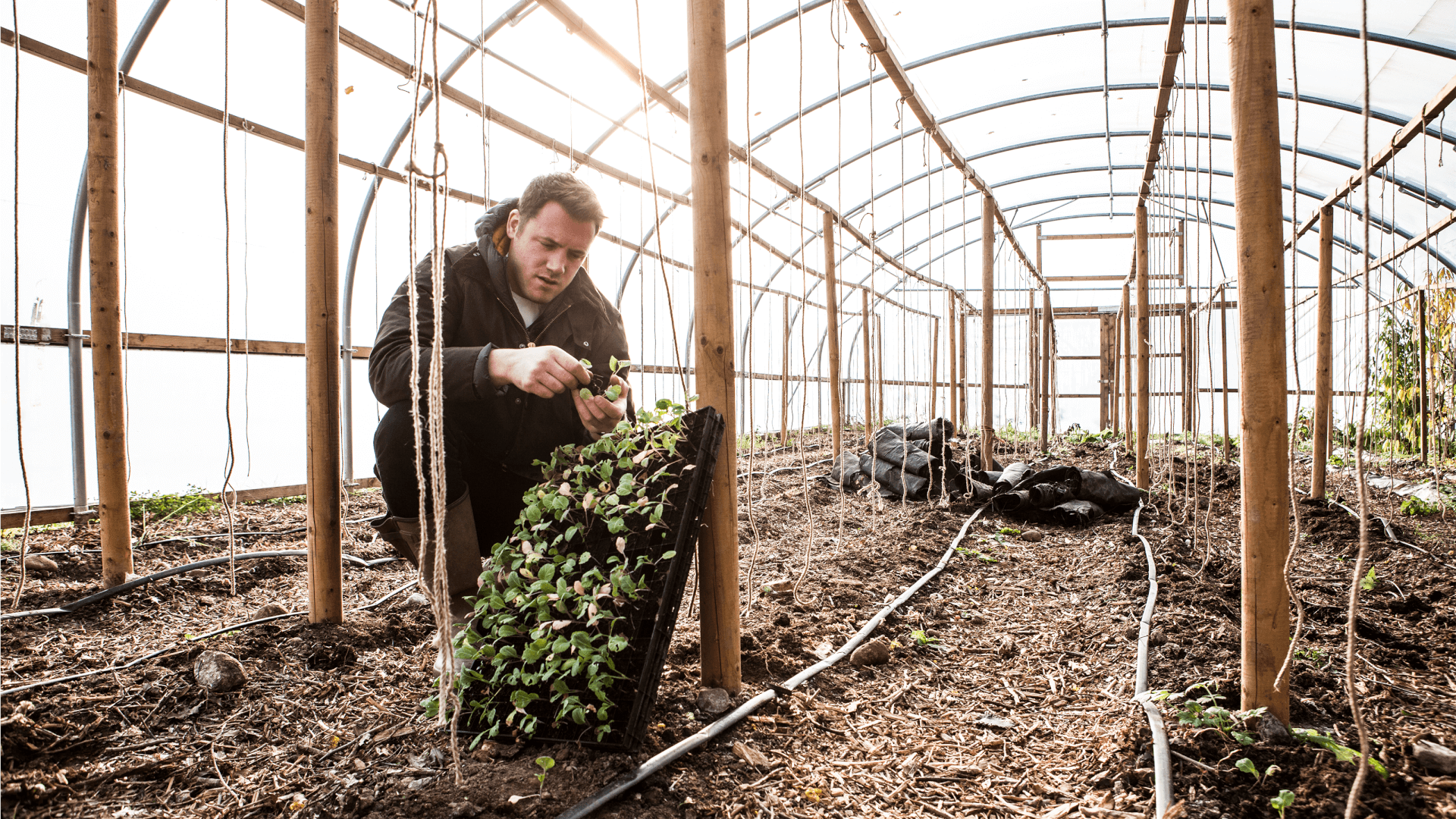Chef Tommy Banks’ Guide To Foraging & Sustainable Cooking
On a Yorkshire farm, in the north of England, I’m handed a tiny orange wild berry with a long, unfamiliar name. “Sea… buck… thorn”. It surely doesn’t sound the most inviting. But as I take a bite, its juice explodes with a sour pop and suddenly I’m transported right back to the taste of a childhood favourite – sherbet-filled Flying Saucers. Next, I’m encouraged to try the leaf of an “anise hyssop” flower, and once again, I find myself walking down memory lane and into an old-fashioned sweet shop, staring up at the glass jars of Aniseed Balls and Black Jacks on the school holidays.
Standing in the rambling farm kitchen gardens of The Black Swan in Oldstead, feels like entering Willy Wonka’s Chocolate Factory. Every new leaf, berry, and flower I taste brims with unexpected flavours that awaken my inner child. Quickly, I’m learning that foraging is like discovering nature’s version of Wonka’s sweets – surprising, vibrant and packed with flavours you never knew existed.
At a time when the food industry is facing countless challenges, foraging has re-emerged as a resourceful and exciting way to eat sustainably. But beyond its practical benefits, Tommy Banks, the celebrated chef behind The Black Swan, shares the opinion that foraging also taps into a sense of adventure and creativity, allowing us to reconnect with nature in a childlike, exploratory way. “The act of being able to venture out and find something, then turn that something into something else… It’s fun, satisfying, sort of arts and craftsy.”
A champion of hyper-local, sustainable and seasonal food, Banks leads an acclaimed portfolio of Yorkshire restaurants, including the Michelin-starred Roots in York, The Black Swan and the group’s newest addition, The Abbey Inn in Byland. Driven by produce grown, picked, or foraged from the Banks; 160-acre farm and three-acre gardens, the team serves up some of the most deliciously experimental tasting menus. Unique foraged ingredients such as sweet woodruff, pheasant berries and douglas fir become welcome additions to the plate, while foods we think we know are utterly transformed through methods of preservation such as umeboshi or fermentation.
It’s an approach to food that’s not just about what’s grown or foraged, but how it’s transformed to push culinary boundaries while being mindful of the environment. Preserving is the second string to the bow, allowing the team to transcend seasonal limitations. “The beauty of preserving is that you take seasons out of the equation because the product no longer has a shelf life,” says Banks.
For Banks, foraging is about tapping into what nature provides – in abundance or scarcity. “Some of our most interesting dishes come from having fewer ingredients to work with,” he says. “For example, at Roots, we created a dessert from potato and chicory root – ingredients you wouldn’t typically think of for something sweet. The challenge of working with preserved or root vegetables forces us to think outside the box. And that’s when the magic happens.”
Above all, his advice is simple: “Get outside, explore, and have fun with it.”
The Beginner’s Guide To Foraging, By Chef Tommy Banks
- Embrace The Simplicity – “Foraging is as much about sourcing food as it is about rediscovering a childlike joy in nature. There’s nothing complicated about it – you step outside, find something wild, and turn it into something delicious. The real magic comes from its simplicity, and the sense of accomplishment you feel when cooking with ingredients you’ve harvested yourself.”
- Start Small – “Identify a few plants that grow abundantly in your area, are easy to recognise and will give you the most bang for your buck. By focusing on those that you know to be delicious and versatile, rather than spending time on rare or complicated finds, you’ll be confident in what to pick and excited about what to make. There’s nothing worse than going to all the effort to find a random ingredient then not knowing what to do with it!”
- Learn The Seasons – “Foraging is all about timing. Understanding what plants to look out for in each season makes the process much easier. If you’re in the UK, wild garlic is one of the first forageables of the year, and luckily has a strong, unmistakable scent – great for making pesto or adding to soups and pasta. As we move into the summer months, something like elderflower, which you see everywhere, is also super easy to identify and there’s so much you can do with it – from cordial to vinegar or even sparkling wine. As autumn arrives, hedgerow fruits such as sloes, damsons, and brambles are out in abundance, and prime for bubbling down into jammy preserves, infused gins or humble pies and crumble.”
- Keep Learning – “There are lots of brilliant resources available to help guide you along the way, from local foraging groups on Facebook to experts such as @chefdickielad (one of Oldstead’s resident foragers) on Instagram. Both are great places to look for tips on what’s in season and where. When it comes to what to do with the plants once you’ve found them, check out @blackswan_oldstead, where the team serve up plenty of recipe ideas. If you want to go more in-depth on the preservation side, The Art of Fermentation dives into the science, while The River Cottage publishes easy-to-understand, practical handbooks.”
- Forage Responsibly – “The risk of over-foraging when you’re doing it at an individual level is relatively low, but it’s always something to be mindful of. If you do pick something quite intensely, you have to understand it might not be able to grow back next year, and that is a shame. It’s also important not to forage flowers as these are crucial for pollination and biodiversity. Nature can heal anything, so long as we treat it with respect.”
Ella Marlow-Gilks is Social Media Manager at Service95




